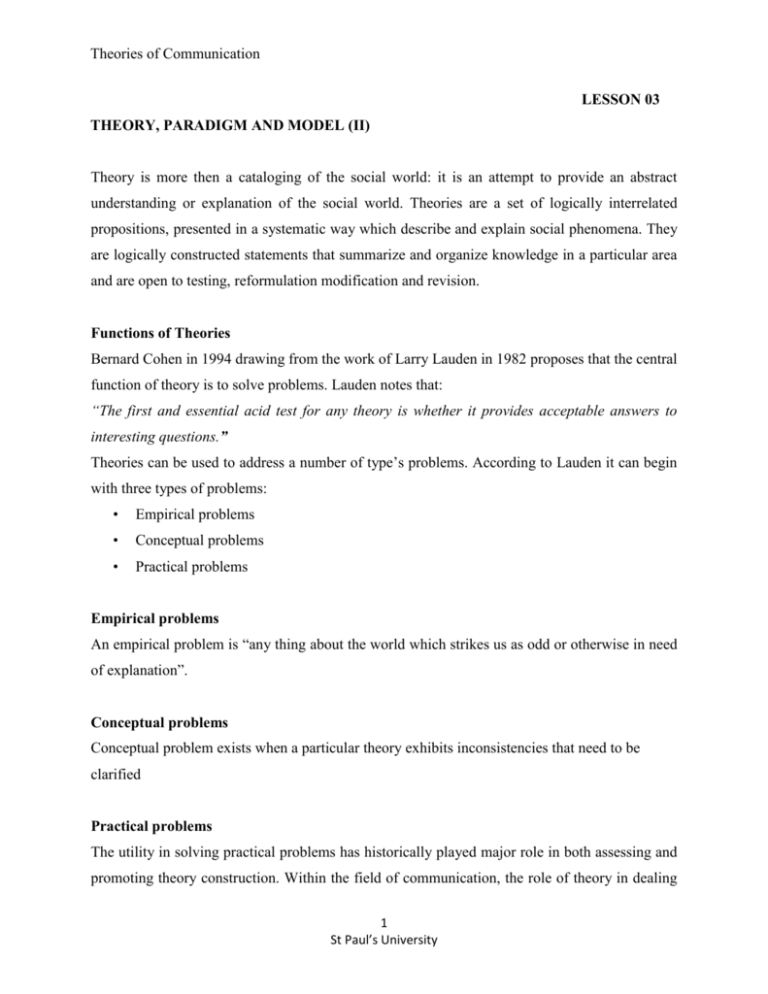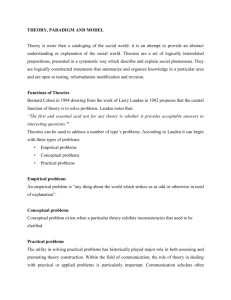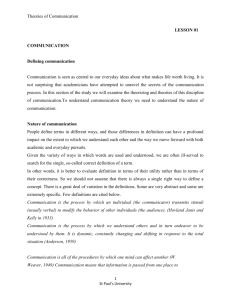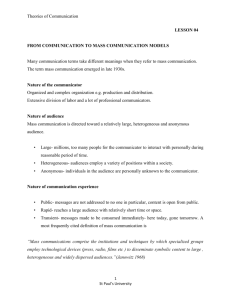Communication Theories: Models & Paradigms
advertisement

Theories of Communication LESSON 03 THEORY, PARADIGM AND MODEL (II) Theory is more then a cataloging of the social world: it is an attempt to provide an abstract understanding or explanation of the social world. Theories are a set of logically interrelated propositions, presented in a systematic way which describe and explain social phenomena. They are logically constructed statements that summarize and organize knowledge in a particular area and are open to testing, reformulation modification and revision. Functions of Theories Bernard Cohen in 1994 drawing from the work of Larry Lauden in 1982 proposes that the central function of theory is to solve problems. Lauden notes that: “The first and essential acid test for any theory is whether it provides acceptable answers to interesting questions.” Theories can be used to address a number of type’s problems. According to Lauden it can begin with three types of problems: • Empirical problems • Conceptual problems • Practical problems Empirical problems An empirical problem is “any thing about the world which strikes us as odd or otherwise in need of explanation”. Conceptual problems Conceptual problem exists when a particular theory exhibits inconsistencies that need to be clarified Practical problems The utility in solving practical problems has historically played major role in both assessing and promoting theory construction. Within the field of communication, the role of theory in dealing 1 St Paul’s University Theories of Communication with practical or applied problems is particularly important. Communication scholars often confront applied issues such as how to improve the provisions of health care how to enhance the effectiveness of problem solving organizational groups. Assessing the quality of theory So in assessing the quality of theory three related questions should be answered: 1. Does the theory solve the problem, regardless of whether that problem is empirical conceptual or practical? 2. Does the solution compare favorably with alternative solutions? 3. Is the solution progressive in that it represents an improvement over its predecessor and opens up new avenues for solving new problems? Models in communication research What are models? Models are a theoretical and simplified representation of the real world. A model is not an explanatory device by itself, but it helps to formulate theory. It suggests relationships, and it is often confused with theory because the relationship between a model and a theory is so close. Definitions “A model is a consciously simplified description in graphic form of a piece of reality. A model seeks to show the main elements of any structure or process and the relationships between these elements”. (McQueen). Deutsch in 1952 pointed out that: 1. Model is a structure of symbols and operating rules which is supposed to match a set of relevant points in an existing structure or process. 2. Models are indispensable for understanding the more complex processes. 3. This is a form of selection and abstraction. 2 St Paul’s University Theories of Communication So a successful pictorial model offers three major advantages: 1. They organize concepts 2. They explain processes and 3. They predict outcomes They organize concepts Models organize concepts by ordering and relating systems to each other and by providing us with images of wholes that we might not otherwise perceive. A model gives a general picture of a range of different particular circumstances. They explain processes Models explain processes by providing in simplified way information which would otherwise be complicated or ambiguous. This gives a model a heuristic function, since it can guide the student or researcher to key points of a process or system They predict outcomes or the course of events Models can at least be a basis for assigning probabilities to various alternative outcomes, and hence for formulating hypotheses in research. KINDS OF MODELS Structural model Functional models Structural model Some models claim only to describe the structure of a phenomenon. In this sense, a diagram of the components of a radio set or diagram of a digestive system etc, could be described as “structural’. Functional models Functional models, describe systems in terms of energy, forces and their direction, the relations between parts and the influence of one part on another. The communication models fall into this 3 St Paul’s University Theories of Communication category, simply all communication is in some degree dynamic and involves some elements of process or change Before we study the communication models lets first look into the most general terms what communication implies. It implies • Sender (encoder) • A channel • A message • A receiver (decoder) • A receiver between sender and receiver • An effect • A context in which communication occurs and • A range of things to which messages refer • Feedback – any process by which the communicator obtains information about whether and how the intended receiver has indeed received the message Three different ways of viewing communication processes 1. Linear model 2. Interactive model 3. Transactional LINEAR MODELS Linear models are based on the principles of stimulus-response psychology, in which a receiver is affected (response) by a message (stimulus) that emanates from a communication source. These models depict the communication process as a series of progressive, linear steps in the transmission of ideas from one person to another. Lass well formula Who says (communicator?) What to (message) In which channel (channel) 4 St Paul’s University Theories of Communication To whom (receiver) With what effect (effect) Lass well formula corresponding with communication research Who says (control studies) What to (content analysis) In which channel (media analysis) To whom (audience analysis) With what effect (effect analysis) Boaddock’s extension of the Lasswell formula Who Says What to In which channel To whom Under what circumstances? For what purpose? With what effect) Shannon-Weaver model One of the first linear models of communication, known as the Shannon-Weaver model, (developed in 1940’s) described the process of telecommunication. They developed a model that depicts a message emanating from an information source, which becomes a signal after passing through a transmitter, depending upon the amount of noise or interference present, the signal passes through to a receiver, where it is decoded as a message. Westley - MacLean model This model (originated in 1950s) differs from the Shannon-Weaver model in that they include mechanism for FEEDBACK or return flow of information from a receiver to the original source, and gate keeping, a mechanism (usually a person) that has the power to control information and even prevent it from reaching a destination . 5 St Paul’s University Theories of Communication The gatekeeper was thought to be an important new dimension of communication models to many in mass communication, because it serves as an analog for editors ,e.g. who control and select the messages that ultimately get to readers of newspapers or viewers of news programs. INTERACTIVE MODELS This model which depicts communication as an interactive process originated in the 1950’s.The Osgood and Schramm interactive model emphasizes the sharing of information between communicator, who gives and receive information interactively. Osgood and Schramm interactive model The circular model describes communication as interactive and interpretive, with communicators almost simultaneously sending and receiving messages. Each person alternates in his or her role as encoder interpreter and decoder of shared messages. TRANSACTIONAL MODELS This model takes into consideration the character of the message and the psychological orientation of the audience member as factors influencing the power of media effects. OTA transactional model The OTA (US office of technology assessment) transactional model separates communication into three distinct processes: 1. Message formulation 2. Message interpretation 3. Message exchange And emphasizes the interdependencies of the processes. 6 St Paul’s University






